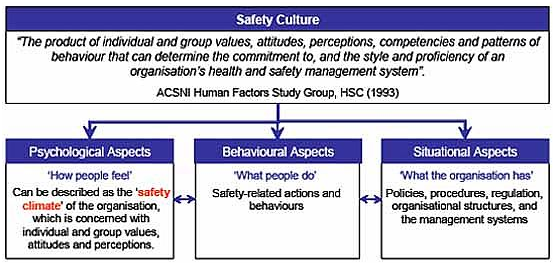A useful safety culture framework
One of the most definitive and well respected definitions of safety culture was developed by the HSE’s Advisory Committee on the Safety of Nuclear Installations (ACSNI: HSC, 1993). This is shown below, along with a framework (Cooper, 2000) commonly used to distinguish between three interrelated, but not mutually exclusive, aspects of safety culture.

The psychological aspects of safety culture relate to ‘how people feel’ about safety and organisational safety management (systems). This encompasses the beliefs, attitudes, values and perceptions of individuals and groups at all levels, often referred to as the ‘safety climate’ of the organisation. This can be measured subjectively through the use of safety climate questionnaires that aim to uncover the workforces' attitudes and perceptions at a given point in time.
The behavioural aspects are concerned with ‘what people do’ within the organisation. This encompasses all safety-related activities and actions of employees at all levels. These aspects can also be described as ‘organisational’ factors.
The situational aspects of safety culture describe ‘what the organisation has’. This is reflected in the organisation’s governance, policies, operating procedures, management systems, communications and workflow systems. These aspects can also be described as ‘corporate’ or ‘structural’ factors.